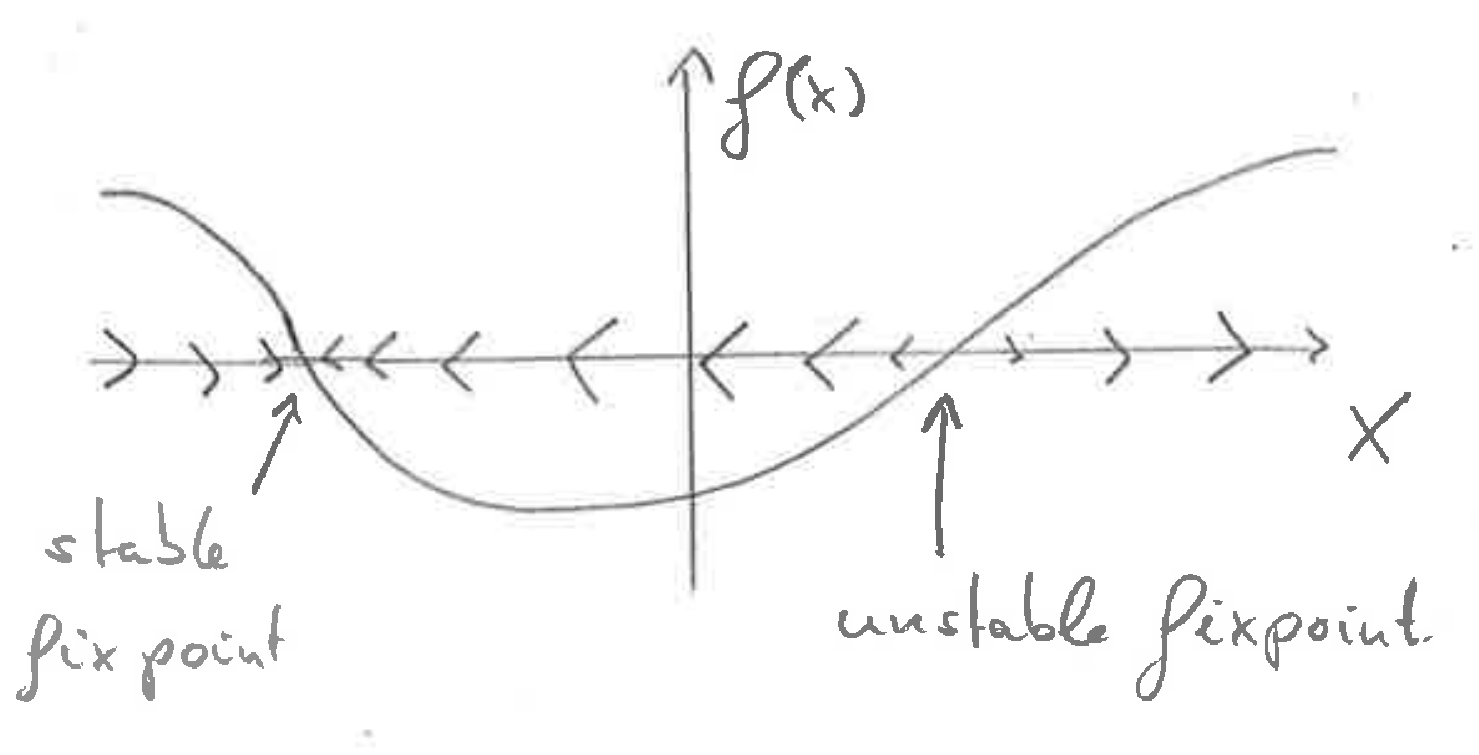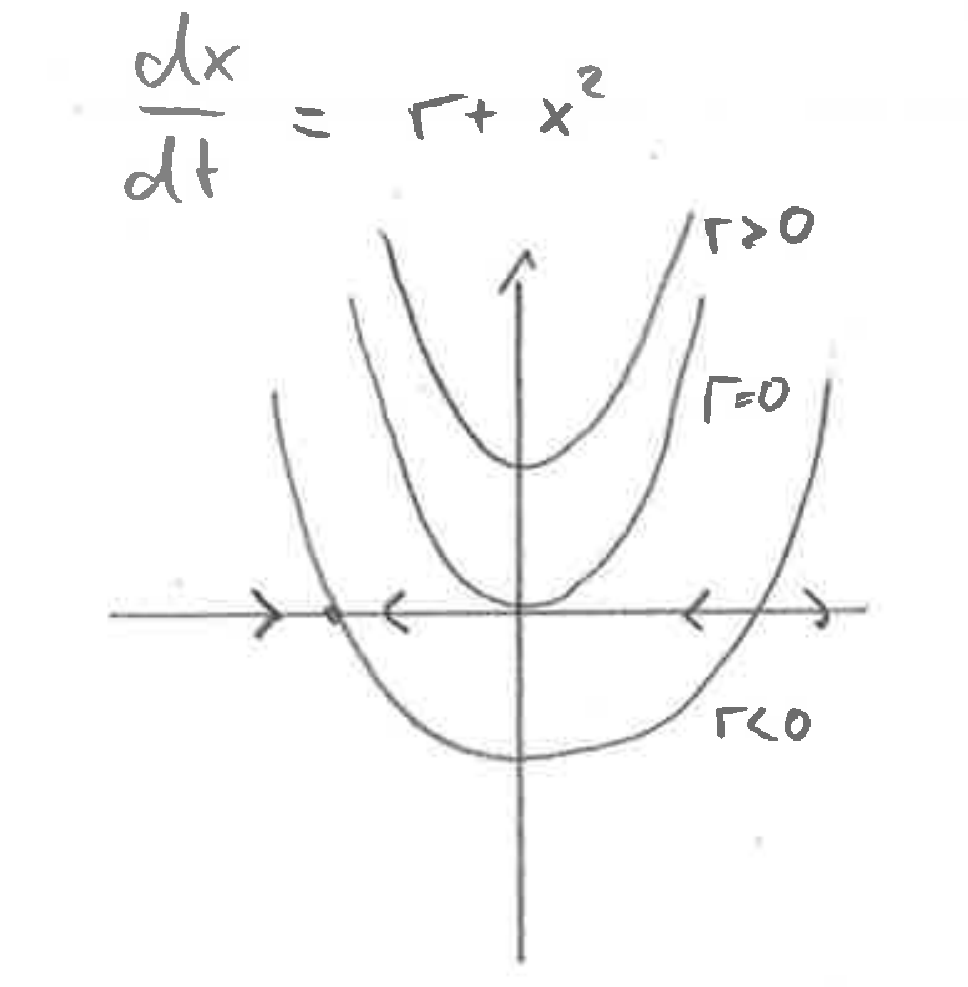After a first glimpse into gene regulation last week, we'll take a more systematic look at dynamical systems today. An excellent introduction into dynamical systems is the book by Steven Strogatz.
One dimensional systems
We will first consider simple systems with only a single variable. Generically, we can write them as $$ \frac{dx(t)}{dt} = f(x) $$ where the function \(f(x)\) determines the temporal derivative at different values of \(x\) (we will assume this function is a constant, i.e., that our system is invariant to translations in time).

Zero-crossings of \(f(x)\) delineate regions in \(x\) where \(x\) is increasing and decreasing. The zero-crossing themselves are so called fixpoints of the system. Fixpoints can be stable or unstable depending on whether small perturbations around the fixpoint decay or grow. As is geometrically evident, \(\frac{df(x)}{dx}<0\) at the fixpoint corresponds to stable fixpoints, \(\frac{df(x)}{dx}>0\) corresponds to unstable fixpoints.
In the immediate neighborhood of the fixpoint \(x=x_c\) the equation above simplifies to $$ \frac{dx(t)}{dt} = (x-x_c) \frac{df}{dx}(x_c) $$ The distance form the fixpoint \(\delta x = x-x_c\) then evolves exponentially as $$ \delta x(t) = \delta x(0)e^{\frac{df}{dx}(x_c)t} $$ This is consistent with our geometric analysis above. The situation when \(\frac{df}{dx}(x_c)=0\) at the fixpoint is special and the dynamics in the vicinity of the fixpoint will depend on higher order properties of \(f(x)\).
Bifurcations
Typically a dynamical system will depend on a number of parameters and the behavior of the system changes as these parameters are varied. Depending on how the parameters affect the properties of \(f(x)\), different things happen.
- if the fixpoints stay in the same place, the only the rates at which fixpoints are approached changes. If the sign of \(f(x)\) is flipped, stable ones go unstable and vice versa
- if the fixpoints move, the domains of attraction of the different fixpoints change with them
- if fixpoints appear/disappear, the solution can change qualitatively
If \(f\) depends continuously on parameters, fixpoints will always appear or disappear in pairs. The simplest such example is $$ f(x)= r + x^2 $$ For \(r>0\), there is no (real) fixpoint and \(f(x)\) is positive along the entire real line. For \(r<0\), there is a stable fixpoint at \(x=-\sqrt{-r}\) and an unstable one at \(x=\sqrt{-r}\).

This bifurcation is called a saddle node bifurcation (for reasons that are really only obvious in higher dimensions). But there is a general pattern: fixpoints appear in stable/unstable pairs.
Two dimensional systems
One dimensional systems are very restricted in what they can do. The can only flow into a fixpoint or run of to infinity. Oscillations are impossible. Two dimensional systems, by contrast are much richer but still sufficiently constrained that a number of general things can be said about them.
The generic system (we'll call variables \(x\) and \(y\) for simplicity) looks like this: $$ \frac{dx(t)}{dt} = f(x,y) \quad \mathrm{and}\quad\frac{dy(t)}{dt} = g(x,y) $$ This is more conveniently formulated as a matrix equation $$ \frac{d}{dt}\vec{x} = \vec{F}(\vec{x}) $$ with a vector valued function \(\vec{F}(x,y)\) and the vector \(\vec{x}= (x, y)^T\).
This vector valued function now defines a flow-field in two dimensions.

The behavior of a system is again governed by its fixpoints. A fixpoint in this case needs to fulfill two conditions: \(f(x_c,y_c)=0\) and \(g(x_c,y_c)=0\).
Nullclines
To get a rough picture of the phase plan of a two dimensional system, it is instructive to look at its nullclines. Null clines are lines in the \(x-y\) plane along which either \(f(x,y)=0\) or \(g(x,y)=0\). The intersection of nullclines are fixpoints. On a nullcline, the dynamics of the system is either completely horizontal of vertical in the phase plane. Furthermore, nullclines separate regions in phase space where \(x,y\) are increasing or decreasing. Faced with analyzing a dynamical system, it is always advisable to draw (or even just sketch) the nullclines.
Assignments
Handwritten notes
(I didn't follow these notes to the letter...)